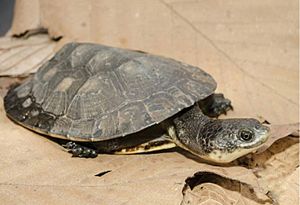Mesoclemmys gibba facts for kids
Quick facts for kids Mesoclemmys gibba |
|
|---|---|
 |
|
| Mesoclemmys gibba | |
| Conservation status | |
| Scientific classification | |
| Genus: |
Mesoclemmys
|
| Species: |
gibba
|
The Mesoclemmys gibba, also known as the toadhead turtle or gibba turtle, is a small turtle. It is called a "side-necked" turtle because it pulls its head into its shell by bending its neck sideways, instead of straight back.
These turtles live in a large part of South America. You can find them in countries like Peru, Ecuador, Colombia, Venezuela, Trinidad, Guyana, Surinam, Paraguay, and parts of Brazil. They are often found near water.
Contents
About the Toadhead Turtle
Toadhead turtles are freshwater turtles. They spend a lot of their time in rivers, streams, and ponds. They are known for their unique way of hiding their head.
What Does It Look Like?
The toadhead turtle is a small to medium-sized turtle. Its shell is usually dark brown or black. The shell is often smooth and somewhat flattened.
Their head is usually dark, sometimes with lighter spots or markings. They have a distinct snout, which gives them their "toadhead" name. Their legs are webbed, which helps them swim very well in water.
Where Does It Live?
These turtles live in warm, tropical areas. They prefer slow-moving water bodies. This includes swamps, marshes, and the calm parts of rivers.
They like places with lots of plants in the water. These plants offer good hiding spots. They also provide food for the turtles.
What Does It Eat?
Toadhead turtles are omnivores. This means they eat both plants and animals. Their diet can change depending on what is available in their habitat.
They often eat small fish, insects, and worms. They also munch on aquatic plants and fruits that fall into the water. They use their strong jaws to crush their food.
Life Cycle and Reproduction
Female toadhead turtles lay eggs. They dig nests in the soil near the water. The number of eggs can vary, but it is usually a small clutch.
After the eggs are laid, the mother turtle leaves them. The sun's warmth helps the eggs to hatch. Baby turtles are very small when they first hatch. They must find food and shelter on their own.
Young turtles grow quickly. They face many dangers from predators. As they get older, they become more independent. They will then find their own mates to continue the life cycle.
Conservation Status
The toadhead turtle is currently listed as "Least Concern" by the IUCN. This means their population is stable. However, like many animals, they face threats.
These threats include habitat loss and pollution. Protecting their homes is important. This helps make sure these unique turtles can thrive for many years.
See also

- In Spanish: Mesoclemmys gibba para niños


